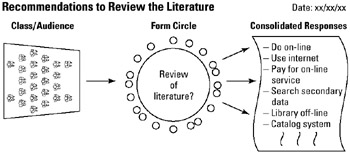Tool 31: Circle Response
| AKA | N/A |
| Classification | Data Collecting (DC) |
Tool description
The circle response technique is ideal for quickly collecting data from participants without forming a team or setting up a session for this purpose. A facilitator or trainer uses this impromptu method to get a response from each participant on a stated question or issue.
Typical application
-
To acquire on-the-spot responses or ideas from a group of participants.
-
To promote involvement of all participants in a learning process.
-
To check what, individually, participants can contribute.
Problem-solving phase
| → | Select and define problem or opportunity |
| → | Identify and analyze causes or potential change |
| → | Develop and plan possible solutions or change |
| Implement and evaluate solution or change | |
| Measure and report solution or change results | |
| → | Recognize and reward team efforts |
Typically used by
| Research/statistics | |
| 1 | Creativity/innovation |
| 4 | Engineering |
| Project management | |
| 5 | Manufacturing |
| 3 | Marketing/sales |
| Administration/documentation | |
| 6 | Servicing/support |
| Customer/quality metrics | |
| 2 | Change management |
before
-
Audience Analysis
-
Buzz Group
-
Different Point of View
-
Run-It-By
-
Surveying
after
-
Consensus Decision Making
-
Circles of knowledge
-
Thematic Content Analysis
-
What-If Analysis
-
Idea Advocate
Notes and key points
-
If there are more than 20 participants, have some participants work together in pairs and input a joint idea or response.
-
Establish a time limit of 30 seconds per person to generate an idea or response.
Step-by-step procedure
-
STEP 1 The facilitator or trainer asks participants to form a circle so that every one can see and hear each other.
-
STEP 2 On a flip chart, a question or issue is displayed to participants. Everyone is asked to respond with an answer or idea to recommend. See example Recommendations to Review the Literature.
-
STEP 3 The facilitator explains the procedure, mentions that they have only about a minute to respond, and explains that no evaluation or interruptions will be allowed.
-
STEP 4 Starting with one participant and moving around the circle, everyone gives his or her input, which is recorded on a flip chart.
-
STEP 5 Once every participant has responded, the facilitator summarizes the data and ends the session by thanking each participant and suggesting that this process may be repeated.
Example of tool application

EAN: 2147483647
Pages: 326